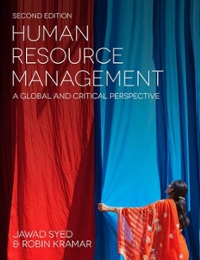Some scholars suggest that managers now talk about diversity both to keep on the right side of
Question:
Some scholars suggest that managers now talk about diversity both to keep on the right side of the law and to ensure the commitment of diverse employees to the organisation and its objectives (Dover et al., 2016). Employers' approaches generally range from a straight lack of interest to a more inclusive approach and positive potential for a long-term business strategy. Some organisations devote little attention to the area, whereas others devote much. There is also some evidence of a negative reaction against EEO endeavours. In particular, the emphasis on affirmative action has sparked most resistance (D'Netto et al., 2000). Previous research suggests that, in most organisations, diversity policies appear to represent a renaming of EEO rather than being an integrated management approach in their own right (Kramar, 2004). An integrated approach is, however, hard to achieve through single-level conceptualisations of diversity management (Syed and Kramar, 2009; Syed and Özbilgin, 2009).
Scholars have expressed some concern that a shift from social-equity-driven EEO to business-benefits-driven diversity management may exacerbate the disadvantaged employment conditions of women, ethnic minorities, and other disadvantaged groups. For example, Humphries and Grice (1995) argue that while diversity management may be seen as a new social division between the core, the periphery, and the unemployed, it ignores the categories that 'illustrate women and other people as not having achieved proportionate representation in the statistics of privilege' (1995: 30-31). The replacement of the discourse of equity with the discourse of diversity may relegate many people from diverse backgrounds to the 'insecure periphery' (1995: 31). In other words, there are serious concerns about the direction and scope of diversity management in improving the conditions of disadvantaged people in the workplace.
There are also some concerns about a predominant emphasis on individuality within the discourse of diversity management. Social identity theory proposes that individuals identify with groups that positively affect their selfesteem and evaluate their own groups by social comparisons to other groups (Tajfel and Turner, 1986). Previous research also suggests that organisational interventions that fail to address the underlying problem of cultural disintegration will not be able to alleviate social disadvantage within and outside organisations (Appo and Härtel, 2003).
Although collective identity is generally ignored in employment contexts, employers are reportedly more concerned about legal regulations. Managers generally seem to be driven by a legal compliance approach (Antonios, 1997), but legislation is generally limited in its ability to bring about cultural and attitudinal change in organisations (Pyke, 2005). Most probably, this is because of the narrow, single-level conceptualisations of diversity management, so that issues related to national culture, structural conditions, and intersectionality (overlapping) of various forms of identity remain generally neglected.
Questions
1 Is diversity management a repackaging of EEO to make it more attractive to business organisations while paying lip-service to disadvantaged workers?
2 What tangible differences in outcomes may be identified as a result of the change from EEO to diversity management?
Step by Step Answer:

Human Resource Management A Global And Critical Perspective
ISBN: 9781137521620
2nd Edition
Authors: Jawad Syed, J; Kramar Syed, Robin Kramar





